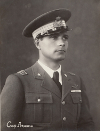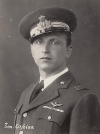Cap. | Aramu | Mario |  On concession of the AM Historical Office in Rome | From L'Ala d'Italia 1933: "He was born in Cagliari on 7 April 1900. He comes from the beraglieri officers. In 1924 he obtained the military pilot's license. In the years 1928 and 1929 took part in the Aviation of Cyrenaica to the operations of great police against the rebels, earning the bronze medal for military valor. E 'fascist of the eve and participated in the March on Rome. "
Mario Aramu, was born in Cagliari on 7 April 1900. In 1918 he graduated from
the technical institute of Cagliari with physical-mathematical address. Between 1918-1919
he attended the two-year engineering course at the University of Cagliari. February 6th
1937 he married in Rome with Olga Lavezzari and November 26 of the same
his son Giorgio was born.
1st category lever soldier at the military district of Cagliari got the
Unlimited leave on April 1, 1918. Two days later he was called to arms and
intended first at the Depository of the 1st Bersaglieri Regiment e
after the 49th Infantry Regiment of the Sassari Brigade.
He attended the Caserta Military School as an official supplementary student
and on March 28, 1919, he was assigned to the Command of the 1st Army a
Trento. From the month of August 1919 to 1923 he was assigned to the Office recoveries of
Mezzolombardo (Trento), then the artillery division of Trento, on the 4th
Bersaglieri Regiment and then sent first under license and then placed in
unlimited leave.
On 3 May 1923 he was transferred, first to the military district of Trento and then
at that of Cagliari.
In 1924 he obtained the airplane pilot's license on an airplane
Sva, at the school of Sesto S. Giovanni (Milan).
From December 1, 1926, he ceased to belong to the roles of the Royal Army and was
appointed "second lieutenant in effective permanent service in the fighting role
of the aeronautical weapon ". In March of 1927 he was promoted and he left voluntary for Benghazi.
From 1928 to 1930 he was in force of the colonial Aviation and took part in the
operations of Cyrenaica, where it was decorated with the bronze medal at the
military valor (Royal Decree of 3 Oct. 1929) with this motivation: "Airplane pilot, in
only a few months was lavished on numerous reconnaissance actions, of
machine-gunning, bombing and transporting injured people, making them precious
services to troops operating on the ground. On 8 August 1928, 4-20 January
1929 in the area of El Carruba, Cigherra and Gara El Mesciarreca,
heedless of enemy fire, with daring offensive actions at low altitude
it surprised and ruffled strong rebel nuclei, bringing them very serious
losses".
Promoted to captain in 1930, he was assigned to the Alto School of Navigation
sea of Orbetello (Grosseto). From 1 July to 12 August 1933 he participated in the tenth-century Atlantic Cruise
(see the archival note) and on August 13th he was then sent to the Course
upper aeronautics of Caserta.
From 13 June 1934 to 20 March 1936, he was sent to China as a member
of the Italian aeronautical mission and as instructor of the School of
bombing of Nanchang.
Promoted major in April 1936, he was assigned to the 12th Wing from
bombing.
From February to October 1937, he participated in military operations in Spain
(begun as early as August 1936) commanding the 29th Bombardier Group
fast. At the end of the campaign he obtained the silver medal for valor
military.
In 1938 he attended the Advanced Studies Course at the Air War School and from the
March 17 to 24, 1938 participated in the 3rd Meeting of the Littorio (air week
International for airplanes for tourism) with an SAI 2 device,
ranking 7th in the test of ascent, descent and landing, 12th in that of
autonomy and night flight, 13th in the speed race and 11th in the ranking
the final.
Promoted colonel, in June 1940, he was assigned to the command of the 9th
Flock land bombardment in Viterbo and September 7, 1940 was transferred
under the command of the Stormo in North Africa, employed by the 5th
Aerial and decorated team of the Order of the Germanic Eagle with swords on the 15th
December of 1940. On December 16, 1940 he was shot down by British fighters and was then decorated
with the gold medal for military valor "Heroic flock commander,
bomber of acceptation twice transporter of the Atlantic, in the days more
fiery enemies of the enemy offensive wanted to be in the sky of battle in the
more prestigious and cruel actions to beat and upset the enemy
with the powerful action of his bombers. Returned for the second time in the
same day in flight, and assaulted by overwhelming and modern hunting
opponents persisted in his offensive action by accepting the unequal battle.
When the gunner and then an officer were dropped from the machine gun,
took the place of the glorious fallen struggling strenuously until it fell
on the burning weapon that clung to his chest he almost embraced the symbol
of his faith ".
On 11 February 1958 the Alghero Airport was named after him. In
cemetery of the Atlantic to Orbetello its name is reported to the left of the
tombstone of Italo Balbo, among those of the fallen in flight on the mainland, while at
the disappeared in the sea are buried right." |
Ten. | Orsolan | Raffaele |  On concession of the AM Historical Office in Rome | From l'Ala d'Italia 1933 "He was born in Fratte (Padua) on July 3, 1905. After completing his classical studies, he was appointed Sub-Lieutenant of Complemento on July 27, 1924, then he moved to Aeronautics. He obtained the military pilot's license on December 18, 1925. Sent to Cologne, he earned the bronze medal for military valor for his actions." |